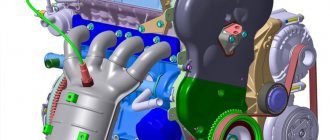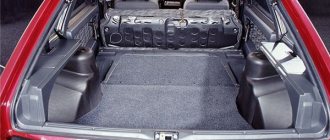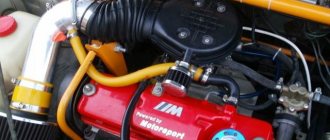VAZ-2109 is a domestic Samara-Sputnik, one of the cars of the former Soviet Union, whose production began back in 1987. Then, 4 years later, in 1991, it was replaced by the VAZ-21093, the technical characteristics of which already included a more powerful 1.5 liter engine. In those years, buying a “nine” (as it was popularly called) or a 93 model was considered great luxury. And although the Union has been gone for a long time, 2109 is still in demand, despite the newfangled features of the Priora and Kalina. What caused this popularity?
In order to answer this question, let’s remember what made Samara stand out. After all, at that moment it was impossible to surprise anyone with a 1.5 liter engine. Earlier models also had such capabilities. As they write, the VAZ-21093 car had front-wheel drive, inherited from its mother - a “nine”, a 5-speed manual and only 6 liters on the highway. It seems like nothing special, but if you sit in the cabin: front windows, headlight adjustment, subsequently the appearance of a tachometer, and some happy car owners could boast of central locking.
Please note that panel 2109 does not have a tachometer. Even when it became a foreign car (we are talking about the 2109 Baltic), it did not acquire a tachometer. Photos of the panel for Baltic can be seen in this article.
"Satellite"
Those who remember Soviet prices, especially those who owned such a car, will agree that 6 liters per 100 km for a family of 3-4 people was a completely acceptable financial burden. But this “Sputnik” made it possible to organize tourist excursions over long distances.
Rear seats for two children in a family, a spacious trunk, low fuel consumption, plus some bells and whistles that the owners of earlier Zhiguli cars could not boast of - you get the VAZ-21093. We will look at the technical characteristics of the car below, but the entire automobile industry of those times did not have a more comfortable car, suitable for both city and country roads. “Nivas,” “fours,” and “twos” don’t count, because when we folded the rear seats, we got a semi-truck version that was larger in volume than the named models. You can mention model 8, the same Sputnik, but do not forget that the “nine” has five doors versus three for the 2108.
Transmission and chassis of the VAZ 21093
The transmission on the VAZ 21093 is structurally made of one unit, including a clutch and a manual gearbox (MT). The gearbox is combined with a differential, the clutch is single-plate. The clutch housing is connected to the flywheel with bolts. To ensure contact with the pressure plate, six elastic plates are used. The gearbox is manual, five-speed. The input shaft gears are constantly meshed with the driven gears. The secondary shaft has two synchronizers.
The car's wheel drive includes two constant velocity joints (CV joints): a rod shaft on the left and a tubular shaft on the right. The front suspension of the car is independent, hydraulic shock absorbers, cylindrical springs. The rear suspension is torsion bar, independent, with a trailing arm design.
The braking system on the 21093 uses front disc brakes and rear drum brakes. There is a diagonal interaction of contours. One circuit includes the right front and left rear wheels, the other - the remaining two. The hydraulic drive of the system includes a vacuum booster and a pressure regulator for the rear brakes.
Appearance of the injector
With the development of production, very soon after the launch of the 2109 model, the VAZ-21099 sedan appeared at AvtoVAZ, which already came with an injection engine. However, the great popularity of the hatchback forced the VAZ team to reconsider plans for the 2109. In 1991, a year after the launch of the 99th model, the VAZ-21093 injector appeared, the technical characteristics of which became the norm for all future nines. As they wrote in press releases of those times, this model is more suitable for a family man and has a less expressive appearance than the 2108. However, with the advent of the 99 model, which received an injector before the 93, the star of Sputnik at AvtoVAZ very soon waned. The model was supported by Ukraine, but production has been discontinued since 2011. It is interesting to note that in Ukraine the car retained its original name, despite the fact that it was assembled at the same plant where Zaporozhets, Tavria and subsequent brands were.
Engine dismantling
You can reduce the weight of the power plant if you remove it without:
- Gearbox (its weight is about 30 kilograms);
- a head weighing approximately 10 kilograms.
As a rule, at service stations, power units are removed assembled with the gearbox, while during self-repair, dismantling is carried out without attachments.
Let's give an example of engine dismantling, which is described in the car's operating instructions. The peculiarity of the work in this case is that the engine is removed through the bottom of the car. The manufacturer recommends not to disconnect the box from it, but to install the car itself on a lift.
- Disconnect the terminals and then remove the battery.
- Drain the coolant and engine oil.
- Remove the crankcase protection.
- Disconnect the muffler and remove the air filter.
- Loosen the brake booster hose clamp that leads to the powertrain inlet pipe.
- Unhook the ground from the crankcase; to do this you will need to unscrew the fasteners.
- Remove the high-voltage wire from the central contact of the distributor cover.
- Using a screwdriver, turn the spring clip and remove the block with the wires coming from the contact socket of the distributor.
- Remove the fuel hose.
- Remove the clutch cable end from the clutch drive lever.
- Disconnect the wires from the traction relay, from the generator output and from the carburetor shut-off valve.
- Disconnect the air supply hoses to the throttle and the fuel hoses leading to the carburetor.
- Remove the spring from the throttle actuator.
- Remove the speedometer and accelerator drive cables from the valve covers.
- Unhook the block with the wire from the economizer, remove the oil pressure and liquid temperature sensors in the cooling system.
- Remove the heater outlet hose and transmission drive rod.
- Next, you will need to disconnect the remaining conductors from the box and move the drive shafts to the side.
- After the steering rod and other parts are disconnected, place a stand under the engine and unscrew the nuts of the rear mounting support, then the right front and left.
Before lowering the engine, check that you have disconnected everything from it. In order to remove the engine from under the car, you need to lift the front part of it.
The 5-speed manual transmission VAZ 2109 was produced at a plant in Tolyatti from 1987 to 2005 and was installed on all numerous front-wheel drive AvtoVAZ models on the 2108-09 platform. This transmission is designed for torque of power units up to 1.6 liters and 120 Nm.
Misconceptions
There are several opinions regarding the specification of the VAZ-21093 model. Technical characteristics: injector, 1.5 liter engine, front-wheel drive, 5 doors, etc. At the same time, other reference literature may indicate other data that includes the same characteristics, with the exception of 1.6 liter engine capacity. But according to the factory specification, all 99, and then 93 models had only a 1.5-liter engine. Yes, there were almost 1600 without a few units, but the specification still classifies them as class 1.5. The batch with a liter engine, which was produced on the basis of the same “mother”, has nothing to do with 93, because it was called 21091.
Body and interior of VAZ 21093
Over the years of production of modification 21093, some changes have occurred in the design while maintaining the same body dimensions. The body of the ninety-third is a five-door hatchback, its front part and radiator have been updated, and a short wing has appeared. The overall and internal dimensions of models 2109 and 21093 are the same down to the millimeter. The interior of car 21093 is five-seater, but it is difficult for three large men to fit in the back. The rear row of seats folds down, almost doubling the trunk volume (from 330 liters to 640 liters).
Main dimensions of the Lada 21093 car.
| Parameter. | Magnitude. |
| Length. | 4006 mm. |
| Width. | 1650 mm. |
| Height. | 1402 mm. |
| Front track. | 1400 mm. |
| Rear track. | 1370 mm. |
| Wheelbase. | 2460 mm. |
| Ground clearance. | 160 mm. |
| Tire size. | 175/70R13, 165/70R13. |
The luxury package had an improved dashboard with a tachometer and an on-board computer, and it was possible to install electric windows and an anti-theft system. Several options were offered for the upholstery and seats: from the most unassuming gray textiles to higher quality colored materials. The interior of the ninety-third was comfortable and practical both for daily trips to work and for relatively long trips with children.
With regard to the body and interior of the VAZ 21093, tuning is quite possible. Experienced motorists often carry out tuning themselves.
Injector or carburetor?
It should be noted that the 93 model was produced in 2 stages. And the main part of the early cars (before 1994) differs from subsequent VAZ-21093 cars. The technical characteristics of carburetor cars are similar to 2109 and 2108. Starting from 1994, and then from 1997, the characteristics of the 93 model began to be exactly the same as the 99 (except for the body): 1.5 liter engine, front-wheel drive, 5-speed manual transmission, system fuel supply from 99, etc. It was because of the appearance of the injector that 93 received new wings, and 99 became longer than the previous ones.
Foreign relatives of VAZ 21093
The Volzhsky Automobile Plant is not the only place where model 21093 cars were produced. Let us note two such projects:
- VAZ 21093 in Finland;
- VAZ 21093 in Ukraine.
Since 1996, the modernized VAZ 21093 was assembled in Finland according to the EuroLada project, the cars were produced under the name Lada Samara Baltic GL (21093-22). A kind of tuning of the VAZ 21093 was carried out. Finnish VAZ 21093 cars were distinguished by bumpers painted in body color, built-in fog lights, had an airbag in the steering wheel, alloy wheels and a catalytic converter. They had ground clearance reduced from 160 mm to 140 mm, a slightly smaller track and a curb weight increased to 1030 kg. In 1998, the project was closed.
Since 1999, nine were assembled from vehicle kits at the Lutsk Automobile Plant (Ukraine). Five years later, production was transferred to the Zaporozhye Automobile Plant (ZAZ). ZAZ organized full-scale production of model 21093. The plant independently produces the car from panels and assemblies. Stamping of body panels was also planned. Some of the cars are equipped with 1.3 liter engines produced by the Melitopol Motor Plant.
At ZAZ, the bodies were welded from Russian-made panels, painted with primer and enamel. For this purpose, the plant had a paint shop, a basic assembly line and a test bench. According to Ukrainian engineers, the quality of the body paint was superior to that of Togliatti. The VAZ 21093 assembly project in Ukraine lasted more than 10 years. The last ninety-third was released in 2012.
In total, the VAZ 21093 was produced for 25 years (from 1987 to 2012), keeping many technical characteristics stable.
Joint venture
It is impossible not to mention the term that was often used in those years. These letters (SP) were also used at the plant in Togliatti. This is how Carlotta appeared - a modification of the Belgians, and 9 Baltic - a joint production with Finland. According to official data, the prototype model 93 was modified - 2109, but in the same years one could also find “Carlotta 93” - a modified model assembled on the basis of the VAZ-21093.
This is what Carlotta looked like. A distinctive feature by which it was recognized even in dense traffic is its dual headlights. And not a dummy, as some Russian craftsmen did with the flat headlights of the Sputnik, but precisely 2 pairs of headlights that turn on separately, like on a six.
And this is what the panel of the European Lada looks like (photo above): a different steering wheel, a different backlight, a different appearance, but the main design features of the panel of the ninth Sputnik still remain unchanged.
93 engine options
There are two engine options for the 21093:
- carburetor VAZ 21083;
- injection VAZ 2111.
Both engines are in-line, four-cylinder, eight-valve and have a displacement of 1499 cm3. The motors are located transversely at the front. Their cylinder diameter and piston stroke are the same, and the compression ratio is 9.9. The engines consume gasoline: carburetor - AI-93, injection - AI-95. The fuel tank capacity is the same - 43 liters.
The VAZ 21083 engine on the VAZ 21093 carburetor model develops maximum power of 70 horsepower at 5600 rpm, and torque is 104 Nm at 3400 rpm. The maximum speed is 154 km/h, the engine accelerates the car to 100 km/h in 13.4 s. Fuel consumption of the VAZ 21093 per 100 km in the city is 8 liters, outside the city - 5.7 liters, in the combined cycle - 6.8 liters. The curb weight is 915 kg.
In 1994, an injector version of the VAZ 21093 was released, designated VAZ 21093i. The technical characteristics of the VAZ 21093i have changed for the better. Engine power increased to 78 horsepower at 5400 rpm, torque was 116 Nm at 3000 rpm. Acceleration time to 100 km decreased to 13 s. Now about how much the car eats. Fuel consumption in the city is equal to 9 liters per 100 km, outside the city - to 5.9 liters, in the combined cycle - to 7.2 liters. The curb weight is 945 kg.
Specifications
It's time to look at the characteristics of our VAZ-21093. Technical specifications, body type, overall dimensions and other information are presented below.
Apart from the details that are indicated a few paragraphs above, the design of the VAZ-21093 (principal, electrical and other circuits) replicated the VAZ-21099 with a high degree of accuracy, except that it was one of the first hatchbacks in the Soviet Union.
And a little more separately about Baltic
Strictly speaking, this car is not a joint production. “Lada-Baltic” is a completely separate line, which was assembled in Finland, a European country, for the European consumer. VAZ had to reach an agreement after sales of export cars began to decline. The quality of our transport has not always been stable, and the Baltic project was born just at the time of one of these cases.
The only thing that remained old about the car was its appearance. At the same time, a foreigner can also be distinguished by its design. Firstly, completely different colors, and secondly, the bumpers, sills and window trims were painted in the general tone of the car (this is how luxury cars looked). Thirdly, it was from these models that the Union came up with the idea of using metallic colors. All color schemes of this Lada came from the metallic line. It can be said, fourthly, that pure black color was not presented in Europe. These colors were produced only for domestic consumers. It is also interesting to note that the Finns have gone further than Russia. On the Internet there are photographs of cars produced in Finland with other bodies.
Decor
Completing documentation is the most important stage of the procedure for replacing a car frame. Especially after the new decree of 2013, registration is carried out only by specialists who are well versed in the laws.
As a rule, registration issues are also resolved step by step. In particular, if the VIN number of the frame is very tattered and it is unreadable.
Note. We advise you to give the car to car service specialists who have everything necessary to carry out the replacement, including guaranteeing the correct execution of all documentation.
The fact is that replacing a car frame was previously regarded as a change in design under current legislation. Before making any changes, the owner of the car was required to submit an application to the traffic police, then he collected the necessary documents, went to the authorities and in the end, everything worked out.
After the law was changed, today it is extremely difficult to obtain a replacement car frame. This explains the fact that this procedure is trusted exclusively to specialists.











